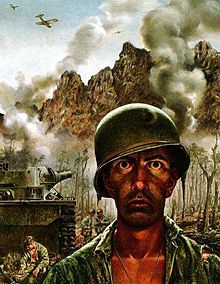- Thousand-yard stare
-
This article is about a military-related term. For the band, see Thousand Yard Stare (band).
 A U.S. Marine exhibits the thousand-yard stare after two days of constant fighting in the Battle of Eniwetok.
A U.S. Marine exhibits the thousand-yard stare after two days of constant fighting in the Battle of Eniwetok.
The thousand-yard stare or two-thousand-yard stare is a phrase originally coined to describe the limp, unfocused gaze of a battle-weary warrior. The stare/gaze is a characteristic of acute stress reaction, also known as combat stress reaction, which is related to post-traumatic stress disorder.[1]
The despondent stare is a symptom displayed by victims who have succumbed to the shock of trauma by dissociating from it. The phrase originated from military circumstances, but it is a symptom of severe psychological distress that can occur anywhere and is not unique to soldiers or settings of warfare.
Contents
Etymology
The phrase was popularized when, in 1945, Life magazine published the painting Marines Call It That 2,000 Yard Stare, by World War II artist and correspondent Tom Lea,[2] although the painting was not referred to with that title in the magazine article. The painting was a portrait of a Marine at the Battle of Peleliu in 1944 and is now held by United States Army Center of Military History, Fort Lesley J. McNair, Washington, D.C.[3] About the real-life Marine who was his subject, Lea said:
He left the States 31 months ago. He was wounded in his first campaign. He has had tropical diseases. He half-sleeps at night and gouges Japs out of holes all day. Two-thirds of his company has been killed or wounded. He will return to attack this morning. How much can a human being endure?[4]When recounting his arrival in Vietnam in 1965, then Corporal Joe Houle said he saw no emotion in the eyes of his new squad: "The look in their eyes was like the life was sucked out of them." Later learning that the term for their condition was the 1,000-yard stare, Houle said, "After I lost my first friend, I felt it was best to be detached."[5]
See also
- Post-traumatic stress disorder (PTSD)
- James Blake Miller
References
- ^ "Marines turn to Greek plays to cope with stress". AP. Aug. 14, 2008. http://www.msnbc.msn.com/id/26203463/.
- ^ Life magazine, 6/11/1945, p. 65. link
- ^ Jones, James, and Tom Lea (illustration), (1975). - "Two-Thousand-Yard Stare". - WW II. - (c/o Military History Network). - Grosset and Dunlap. - pp.113,116. - ISBN 0448118963
- ^ ""War through the eyes of artists"" (Transcript of televised broadcast). America's Defense Monitor, Program Number 438. Center for Defense Information. 1991. http://www.cdi.org/adm/Transcripts/438/. Retrieved 2006-10-27.
- ^ Stone, Sgt. Arthur L. (2002-05-02). "Retired Sgt. Maj. Joe Houle recounts Vietnam tour". Marine Corps News. http://www.usmc.mil/marinelink/mcn2000.nsf/ac95bc775efc34c685256ab50049d458/8162e24d774ce14885256fea006f5222.
External links
Wikimedia Foundation. 2010.

